
Best practices to structure your Apple Ads search results campaigns
In the fiercely competitive world of the App Store, visibility is everything. With millions of apps vying for user attention, securing a top spot in search results can make or break an app’s success. Apple Ads offers app growth marketers and developers a powerful way to reach high-intent users at the exact moment they’re searching for an app like yours.
But running search results campaigns effectively isn’t just about bidding on keywords. It’s about the soundness of your Apple Ads campaign structure. In this article, we’ll break down the most effective strategies for running successful search results campaigns so you can stay ahead of the competition and drive meaningful growth for your app. At AppTweak, our data scientists and app growth consultants have uncovered some precious gems to help unlock the full potential of your campaigns.
Key takeaways
- Set clear campaign goals that you want to achieve by optimizing your Apple Ads campaigns.
- Leverage a modular campaign structure for efficient scaling.
- Organize ad groups by match type and user intent to better align bids and creatives with user expectations.
- Capture users across multiple regions by integrating smart bid management and localized campaign strategies.
- Invest in continuous keyword research to support both Apple Ads and ASO efforts.
- Always keep a budget for Discovery Campaigns to find new users.
- Optimize bids instead of pausing keywords to improve cost efficiency without losing visibility.
- Localize your campaigns with tailored messaging, creatives, and bids for each target region.
- Ensure alignment between your ad strategy and app store presence (title, creatives, and reviews).
- Regularly assess performance data to refine structure, bids, and audience targeting for higher ROAS.
What is an Apple Ads campaign?
An Apple Ads campaign refers to a set of ads, ad groups, and keywords that work together to promote an app on the App Store.
Components of an Apple Ads campaign:
Ad groups: Clusters of keywords that share a common theme or target a specific audience.
Keywords: Search terms that trigger your ads to appear on the App Store.
Ad creatives: Headlines, ad copy, images, or videos that entice users to tap on your ads.
We’ll cover all three of these components below and discuss how to use them to create a solid Apple Ads campaign structure.
Why is it important to structure your Apple Ads campaign?
With over 650 million people visiting the App Store each week, standing out is more challenging than ever. Apple reports that nearly 65% of app downloads occur directly after a search on the App Store, underscoring the importance of Apple Ads for app discovery.
A well-structured Apple Ads campaign helps ensure your targeting, bidding, and creatives work in harmony. It allows you to reach high-intent users at the right moment, allocate budget efficiently, and scale performance across geographies. Without a clear structure, even strong keywords or engaging ads can underperform, leading to wasted spend and missed growth opportunities.
What to consider before you structure your Apple Ads campaigns?
While setting up your Apple Ads campaign structure is relatively simple, it’s paramount to perform the proper keyword, competitor, and audience research. Review the following points before you set up your campaigns.
Define your campaign goals
Before creating an Apple Ads campaign, it is essential to clearly define your goals and objectives. Are you looking to increase app downloads, defend your brand, increase brand awareness or improve user engagement? By identifying your desired outcomes, you can tailor your campaign structure, budget allotment, and bid strategy.
Understand your target audience
Before you launch your Apple Ads campaigns, you need to go beyond keywords and creatives. A deep understanding of your target audience will help you build smarter campaigns that drive higher conversion rates and more efficient spend. Here are three key dimensions to consider when creating your Apple Ads campaign structure:
1. Demographics: Who are your users?
Start by identifying the core demographics of your app’s ideal users. This includes:
- Age range: Are you targeting teens, young adults, or older users?
- Gender: Is your app geared toward a particular gender?
- Location: Which countries or regions are your users coming from?
- Language preferences: Are you targeting multilingual users or specific locales?
Knowing this will help you segment your campaigns geographically, tailor your creatives, and decide which markets to prioritize. If you’re targeting multiple countries, consider creating localized campaigns with tailored messaging and bidding strategies.
2. Psychographics: What motivates them?
Did you know that 91% of smartphone owners plan or make a purchase after seeing a relevant ad? That’s why it’s critical for your ad preparation to consider psychographics. Psychographics refer to the psychological characteristics of your target audience, such as their interests, values, lifestyles, attitudes, and motivations.
Consider the psychographics of your users:
- Lifestyle: Are your users fitness enthusiasts, gamers, finance professionals?
- Pain points and goals: What problems does your app solve for them?
- App usage habits: Are they likely to make in-app purchases? How often do they engage?
Taking into account psychographic traits allows you to create messaging that resonates emotionally and aligns with user intent, whether you’re aiming for brand awareness, installs, or re-engagement.
3. Device preferences: Where are they coming from?
Apple Ads allows you to refine targeting based on device type and user behavior. Consider:
- iPhone vs. iPad: Are your users more active on mobile or tablet?
- OS versions: Are your features optimized for the latest iOS versions?
Bonus: new vs. returning users post-launch
Once your campaigns are running, you can further optimize performance by segmenting first-time downloaders from returning users. Apple Ads allows you to tailor ads to these audiences—helping you refine messaging and encourage re-engagement.
Tailoring your bids and creatives by device can significantly impact campaign performance. For example, if your app delivers a better experience on iPhone 14+, you can bid more competitively for users with those devices.
To get the latest app screenshot, video, and icon sizing requirements, check out our app store screenshots guidelines blog.
Assess your current app performance
Before putting budget into Apple Ads, take a close look at how your app store listing is performing. Your product page is often the final step before users tap to download. If it doesn’t align with user expectations or fails to convert, even the most precisely targeted ads with the best Apple Ads campaign structure will fall short.
Apply relevant keywords to metadata
Start by evaluating whether your app listing speaks directly to the audience you’re targeting through Search Results campaigns. For instance, if you’re bidding on terms like “budget tracker app,” but your subtitle or description barely mentions budgeting, users may drop off without installing.
Use clear and engaging creatives
Visual assets matter just as much. Icons, screenshots, and app previews should instantly communicate your app’s core value and appeal to your primary audience. Poorly designed or irrelevant visuals can cause hesitation, even if your ad was compelling.
For example, in the ad below, Garden app uses the word “plant delivery” in its creative copy on one of its screenshots, which is related to one of its top keywords “plant delivery”. This word paired with the image of a map easily showcases one of the key benefits of the app.
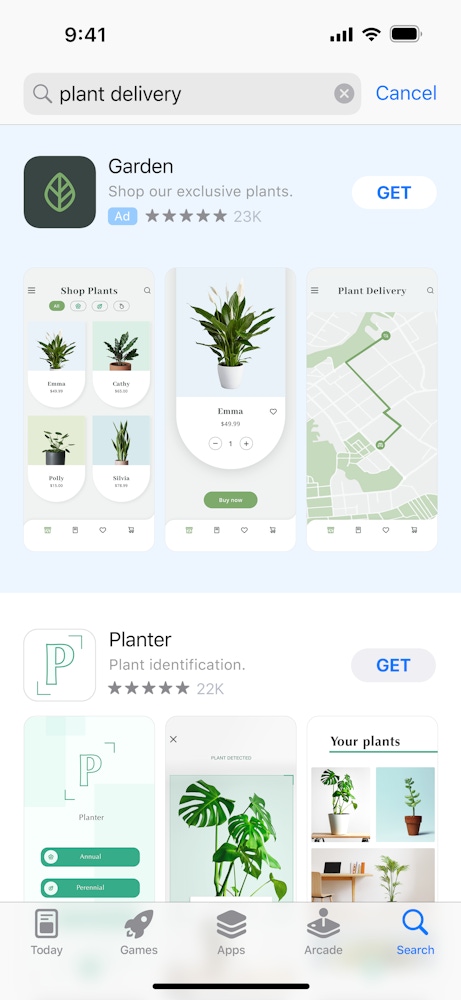
Optimize for the best by A/B testing
Running A/B tests on store creatives is a proven way to improve your conversion rate (CVR) and lower cost-per-install (CPI). Small adjustments like changing the order of screenshots or rephrasing a call-to-action can have a meaningful impact.
For example, a meditation app that highlights “Reduce stress in 5 minutes” with a calming first screenshot is far more likely to drive installs than a vague or cluttered image.
For a deep dive into A/B testing and a downloadable checklist, check out A/B testing in ASO: the basics and beyond.
Ultimately, a strong app store listing acts as a natural extension of your ad. When your messaging and visuals are aligned, your campaigns are more likely to convert efficiently.
Investigate search intent
At AppTweak, we believe that understanding search intent is key to optimizing your Apple Ads campaigns. By leveraging our platform, you can uncover the most relevant keywords for your app, ensuring you attract users who are actively seeking what you offer. Here’s how you can harness AppTweak’s features to maximize your search intent strategy and set up your Apple Ads campaign structure for success:
Identify relevant keywords
Use AppTweak’s robust keyword analysis to pinpoint terms that align closely with your app’s features and benefits. Our insights help you focus on the language your target audience is already using.
Understand Apple’s keyword match types
To match your ads with the right users, Apple Ads supports three keyword match types. Match types determine how closely a user’s search term must match your keyword for your ad to appear. Each determines how closely a user’s search term needs to align with your chosen keyword in order for your ad to show.
- Exact match: Your ad shows only when someone searches for your exact keyword (or very close variations). This is best for branded or high-intent terms.
Example: “habit tracker app” - Broad match: Your ad shows for search terms that are related to your keyword, including synonyms, plural/singular versions, and even common misspellings. This helps you reach more users during discovery.
Example: “fitness app” could trigger “workout tracker”
Additionally, Apple offers a feature called Search Match, which automatically matches your ad to relevant searches based on your app’s metadata and category—no keyword input required. It’s ideal for uncovering new keyword opportunities when you’re getting started or scaling
Each match type offers a different level of control, reach, and intent targeting,and you’ll use these strategically when building your Apple Ads campaign structure.
Utilize keyword research tools
With AppTweak’s dedicated app keyword research tools, discover high-potential keywords, assess search volumes, and understand competitive dynamics. These data-driven insights empower you to refine your keyword selection for optimal performance.
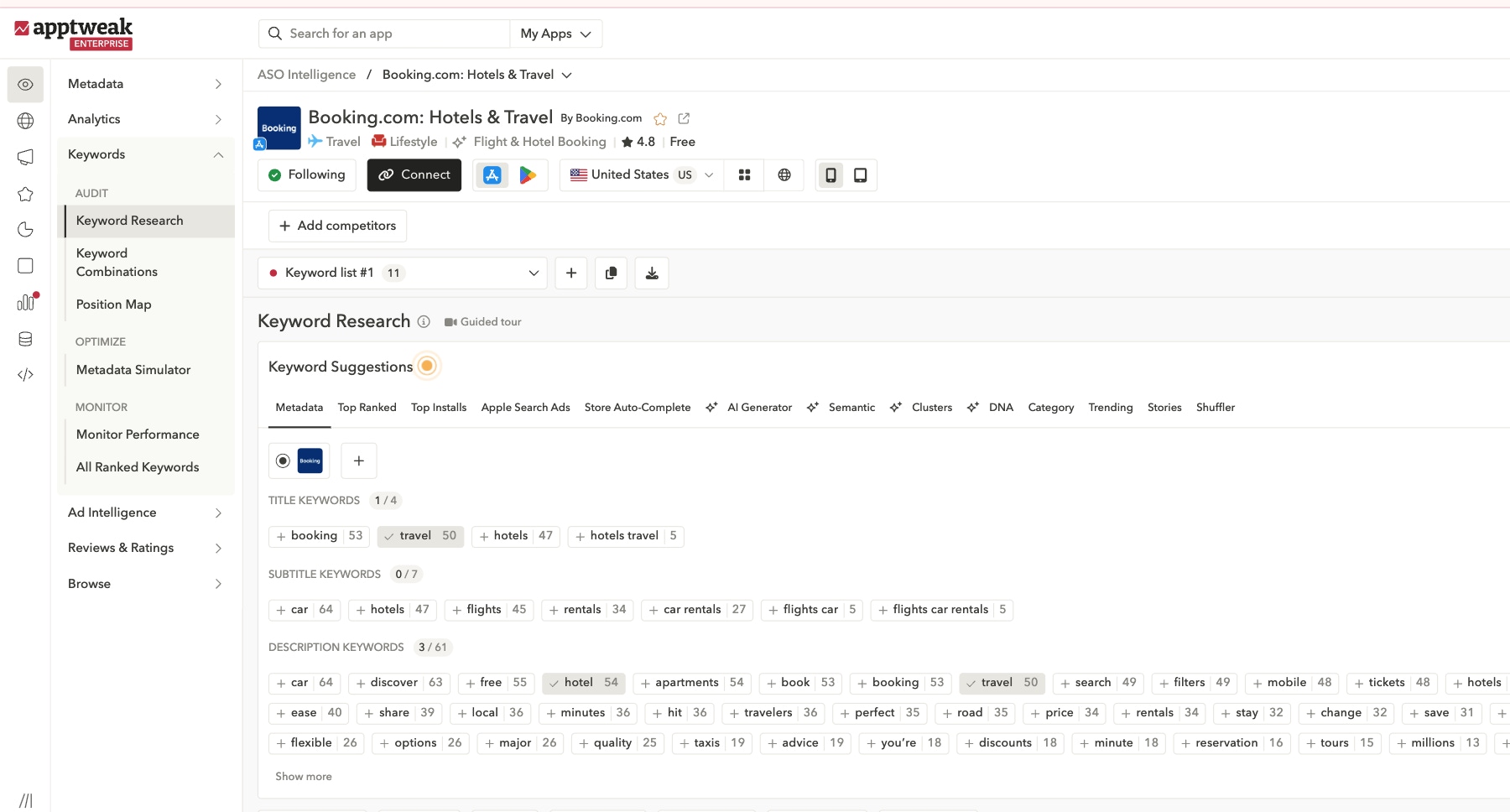
Analyze competitor keywords
Our competitive analysis tools let you dive deep into your competitors’ keyword strategies. See which terms are driving success in your niche and uncover opportunities that can give your app a competitive edge.
Balance brand and generic terms
AppTweak enables you to seamlessly blend branded keywords with generic ones. This balanced approach helps you capture a wider audience by targeting loyal users through brand terms while also reaching new prospects with generic search queries.
By integrating these strategies through AppTweak, you can ensure your Apple Ads Search Results campaigns are perfectly aligned with user search intent—leading to increased visibility, higher engagement, and improved conversion rates.
What’s your budget?
Setting the right budget is essential for any successful Apple Ads campaign. Here’s how to effectively manage your spending:
- Overall budget: Establish the total amount you plan to invest in your campaign. Use historical data and market benchmarks to ensure your overall budget is aligned with your campaign objectives.
- Daily budget: Apple Ads uses a daily budget model that calculates your monthly spend based on the average number of days in a month (30.4). You may exceed your daily budget on high-opportunity days, but you won’t exceed your total calculated monthly spend. You can increase or decrease your daily budget anytime to respond to performance trends or campaign shifts.
- CPT bids (cost-per-tap bids): Optimize your cost-per-tap bids to balance cost efficiency with ad visibility. Analyze previous performance data and competitor strategies to fine-tune your bids, ensuring you get the best return on your investment.
By managing these components carefully, you can maximize your campaign’s effectiveness, driving better engagement and higher conversion rates while staying within your budget.
Segment your campaigns into different audiences
Segmenting your campaigns allows you to tailor your advertising efforts and reach specific audiences more effectively. Here are some strategies to consider:
- By objectives: Organize your campaigns based on your primary goals—whether that’s driving downloads, increasing user engagement, or boosting in-app purchases. This enables you to create targeted messaging and allocate budgets accordingly.
- By geography: Customize your campaigns based on geographical locations. This helps you address regional preferences, languages, and cultural nuances, ensuring your ads resonate with local audiences.
- By match types: Separate your campaigns by keyword match types (such as exact or broad match) to manage bids and performance more efficiently. This approach lets you experiment with different targeting strategies and optimize based on which match type delivers the best results.
By segmenting your campaigns into distinct audience groups, you can better tailor your strategies, optimize your ad spend, and ultimately achieve higher engagement and conversion rates.
Plan for localization
When planning your Apple Ads campaigns, it’s essential to consider localization. This is key not only to connect with diverse audiences but also to manage bids and spend effectively to maximize your ROAS.
Language customization
Tailor your ad copy and creatives to each target language. By communicating in users’ native tongues, you can increase engagement and relevance, leading to more efficient spend and higher conversion rates.
Regional and cultural adaptation
Adapt your campaigns to fit local markets by considering regional trends, seasonal events, and cultural nuances. This allows you to fine-tune your bids and budgets for each region, ensuring that your investment yields the best possible ROAS.
Beyond language, adjust your messaging and visuals to resonate with local cultural preferences. Culturally relevant content can enhance user trust and drive better performance across different demographics.
In the example below, AppTweak clients adjusted their U.S. screenshots for the Japanese markets. Beyond updating the language, they learned that in Japan, users prefer a single message per group of screenshots (rather than one message per screenshot). After localizing their screenshots, our clients saw a significant uplift in downloads in the Japanese market.
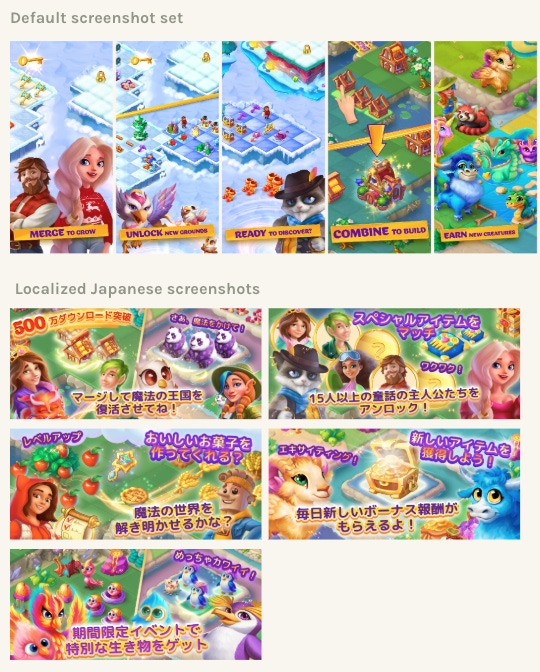
Optimized bid management
Use localization data to set region-specific bids. Monitoring performance by language and geography helps you allocate budget effectively, ensuring you’re not overspending in markets that underperform while capitalizing on high-converting regions.
Monitor keyword and competitor trends
Stay ahead of the market by tracking localized keyword trends and competitor strategies. Regularly reviewing search trends and competitor activities in different regions can provide insights for adjusting your keyword targeting and bid strategies. This proactive approach ensures that your campaigns remain competitive and relevant, leading to better performance and improved ROAS.
Want help with this? Learn more about AppTweak’s Competitor Keywords feature.
Spend efficiency and ROAS maximization
Continuously analyze your campaigns to manage spend efficiently. By adjusting budgets and bids based on localized performance metrics, you can maximize ROAS and ensure every dollar works harder for your campaign.
Key steps in structuring Apple Ads campaigns
Here’s your step-by-step guide to setting up your Apple Ads campaigns.
Step 1: Choose between Apple Ads Basic and Advanced
The first step in structuring your Apple Ads Search Results campaign is selecting the right campaign type to match your goals, expertise, and resource availability. Apple Ads offers two distinct advertising solutions designed to accommodate varying levels of expertise, resources, and marketing objectives.
Apple Ads Basic overview
Designed for advertisers who prefer a simplified, hands-off approach, Apple Ads Basic automates most of the campaign process. It operates on a cost-per-acquisition (CPA) model, where you set a target cost-per-install (CPI) and Apple optimizes delivery to meet that goal. Simply put: Set your Goals. Set your budget. Grow your business.
Key features:
- Automated ad creation and bidding.
- Minimal setup required, ideal for smaller budgets or advertisers new to Apple Ads.
- Focus on driving app downloads without the need for intensive manual management.
When to choose Apple Ads Basic:
Apple Ads Basic is a great fit if you’re looking for a straightforward, automated solution that requires minimal setup. It’s especially useful when time or resources are limited, and you don’t have the capacity to manage detailed campaign settings. This campaign type works best for smaller-scale efforts focused on driving app downloads without the need for complex targeting or advanced optimization.
Apple Ads Advanced overview
Built for advertisers seeking more control and customization, Apple Ads Advanced offers powerful targeting, bidding, and optimization features. This campaign type allows you to fine-tune every aspect of your strategy—from keyword selection to performance tracking—making it ideal for growth-focused teams or experienced marketers.
Key features:
- Manual keyword selection and match types for precision targeting.
- Customizable bids and budgets at the keyword and ad group level.
- Access to advanced audience segmentation and geographic targeting.
- Performance dashboards for in-depth analysis and optimization.
- Creative sets to tailor visuals to specific audience segments or keyword themes.
When to choose Apple Ads Advanced:
Apple Ads Advanced is ideal if you want full control over keyword targeting, bidding, and budgeting. It’s well-suited for large-scale or region-specific campaigns that require custom segmentation and more granular strategy.
This option is best for teams focused on long-term growth through performance optimization and data-driven iteration. If you’re working with a larger team, an agency partner, or have in-house user acquisition expertise, Advanced gives you the flexibility and tools to scale effectively and have more control over your spend.
Comparison of Apple Ads Basic vs. Advanced
For an easy visual comparison, check out the table below to see which campaign type is right for your app business. And for a deeper dive, you can find more information on each product on the Apple Ads Help page.
| Apple Ads Basic vs. Advanced | ||
|---|---|---|
| Feature | Apple Ads Basic | Apple Ads Advanced |
| Setup effort | Miminal: Quick launch with automated settings | Manual: Full control over structure and targeting |
| Targeting options | Automated targeting | Keyword-level, audience, and geographic targeting |
| Budget flexibility | Monthly budget with a maximum of $10,000 per app | Custom daily budgets and cost-per-tap bids |
| Ad creation | Auto-generated from metadata | Control over ad group structure and creative sets |
| Performance insights | Limited reporting | Detailed analytics and optimization tools |
| Best for | Simplicity without heavy involvement | Granular optimization and growth at scale |
By carefully choosing between Apple Ads Basic and Apple Ads Advanced, you can align your campaign strategy with your overall goals, ensuring efficient budget management, optimal targeting, and the best possible performance for your Apple Ads efforts.
Note: The rest of the steps are for Apple Ads Advanced campaigns.
Step 2: Structure your Apple Ads campaigns by goal
Segmenting your campaigns by specific goals allows you to tailor your strategies, optimize your bidding, and effectively allocate your budget.
Here’s how to structure your campaigns based on distinct objectives. We’ve also included our recommended budget allocation for each, which can vary depending on whether you’re launching a new app or promoting an already established one. Note that further on, we’ll dive deeper into each campaign type.
Brand Campaigns:
- Objective: Protect and promote your brand identity.
- Strategy: Target searches that include your app’s name or branded terms.
- Benefits: Helps ensure that users looking for your app find it quickly, reducing the chances that competitors capture your traffic.
- Recommended budget allocation: 30%
Competitor Campaigns:
- Objective: Capture users who are interested in similar apps by targeting competitor names or related terms.
- Strategy: Bid on competitor-related keywords to attract users who might be looking for alternatives.
- Benefits: Provides an opportunity to divert traffic from competitors, potentially increasing your market share.
- Recommended budget allocation: 30%
Category Campaigns:
- Objective: Reach a broader audience by targeting general keywords related to your app’s category or functionality.
- Strategy: Use broad match keywords that reflect common search queries relevant to your app.
- Benefits: Increases overall visibility and helps tap into a wider pool of potential users who are exploring options within your category.
- Recommended budget allocation: 35%
Discovery Campaigns:
- Objective: Identify and target emerging keywords and search trends that can drive new user acquisition.
- Strategy: Focus on experimental or less competitive keywords that might uncover untapped market opportunities.
- Benefits: Facilitates ongoing keyword discovery, allowing you to refine your campaigns over time and capture new audiences as search behaviors evolve.
- Recommended budget allocation: 5%
By segmenting your campaigns based on these specific goals, you can craft targeted messaging and bidding strategies that improve ad relevance, optimize your spend, and ultimately drive better conversion rates across different user segments.
Step 3: Further segment your audience/user-intent by classifying keywords into separate ad groups.
Once your Apple Ads campaign structure is aligned with your business goals, the next step is to organize your ad groups by user intent, or your niche segments.
Targeted bid management
Strategic bidding is one of the most powerful levers you have in Apple Ads. Rather than applying a flat cost per tap (CPT) across all keywords, targeted bid management allows you to prioritize spend on high-intent, high-performing terms—and reduce waste on underperforming ones.
Start with clear segmentation
Isolating match types makes it easier to evaluate performance at a glance. So, separate your keywords by intent (e.g.TOFU keywords vs core keywords). This makes it easier to allocate budget effectively and analyze which groups deliver results.
Clearly segmented ad groups lead to make informed decisions on custom targeting down the line.
Match creatives to user expectations
Finally, creative alignment becomes easier when your ad groups are segmented by keyword match type. You can tailor messaging in each ad group based on match type. Exact match users may respond better to direct, benefit-driven messaging, while broader terms may require more educational or aspirational positioning.
This foundational setup for your Apple Ads campaign structure will help streamline performance analysis and make future optimizations more effective, especially as you scale or layer in custom product pages.
Better align with user intent
By placing exact and broad match keywords in separate ad groups, you can customize bids based on user intent.
Let’s say, for example, that you have a money-saving app. A user searching for “budget planner app” is likely more valuable than someone searching for the more general keyword “finance tools.” With this in mind, you’d want to prioritize bids for “budget planner app”.
Segmenting your keywords by user intent allows you to bid with higher priority on high-intent traffic while controlling spend on exploratory searches.
Step 4: Choose the right keywords to bid on
Selecting the most relevant keywords is a fundamental step in creating effective Apple campaigns. Here’s how to strategically identify the right keywords for your Apple Ads campaign structure.
Align with user intent
Focus on keywords that mirror the search behavior and needs of your potential users. Understanding what your audience is likely to search for helps ensure your ad is seen by those with a genuine interest in your app.
Prioritize relevance
Evaluate keywords based on their relevance to your app. This means choosing terms that accurately describe your app’s functionality, features, and overall value proposition. High relevance often translates into higher conversion rates and a ROAS.
Consider search volume and competition
Analyze both the search volume and the competitive landscape of potential keywords. High-volume keywords can drive more impressions, but they may also be more competitive and expensive. Balancing these factors is key to maintaining cost efficiency.
Leverage data-driven insights
Use keyword research tools and performance data to inform your decisions. Tools that provide insights into search trends, competitor keywords, and historical performance can help you refine your keyword selection, ensuring you bid on terms that are most likely to deliver results.
In the example below, AppTweak’s Campaign Manager reveals how the gaming app Block Blast! is performing in the U.S. market. You can see which keywords the app is actively bidding on, along with key metrics like paid impressions and market share, offering valuable competitive insights for your own strategy.
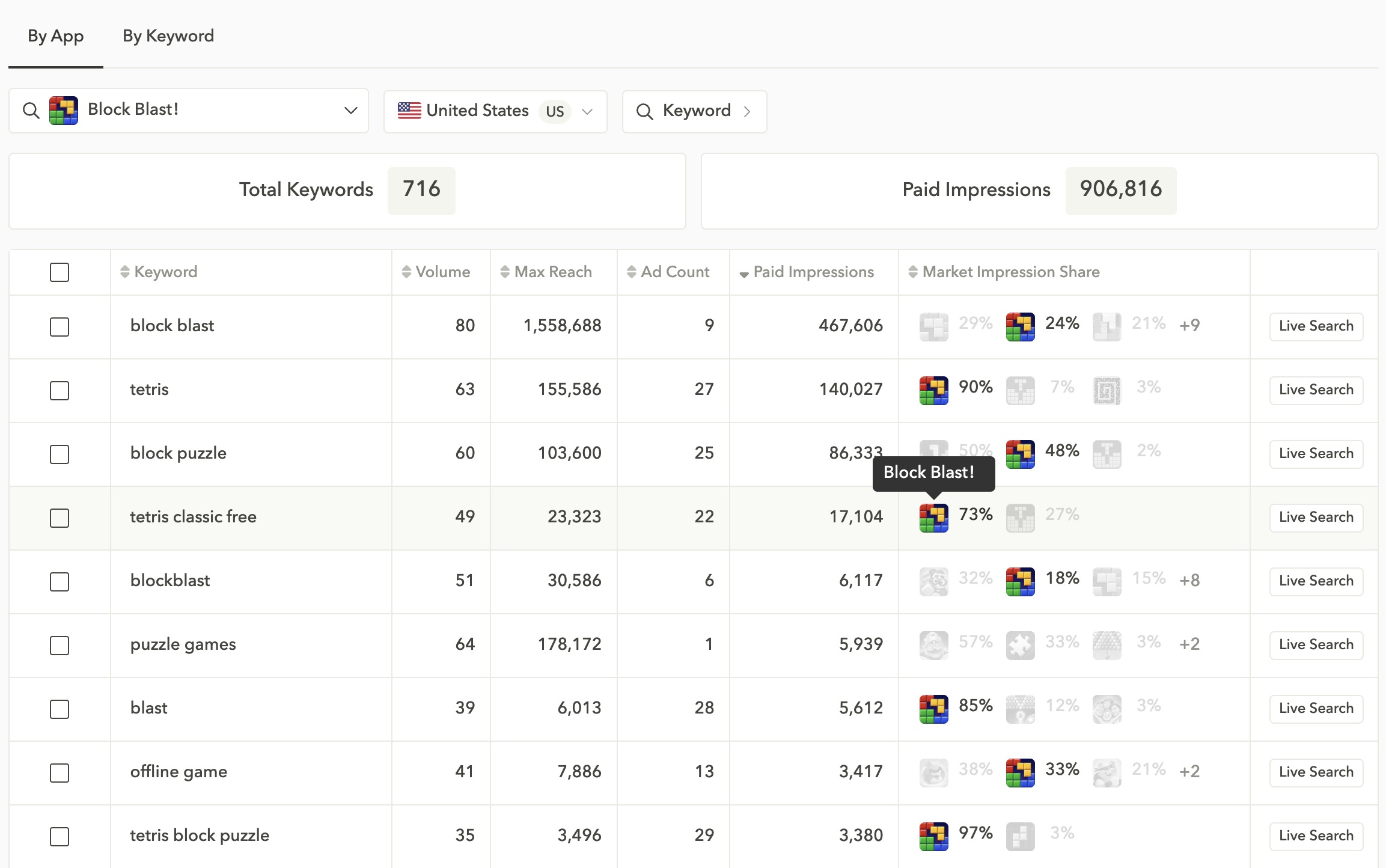
Regularly refine your list
Keyword performance can shift over time. Continually monitor and update your keyword list based on campaign data and emerging trends, ensuring that your strategy stays aligned with evolving user behavior and market conditions.
Step 5: Localize your campaigns for global reach
Localizing your Apple Ads campaign structure isn’t just about translating keywords—it’s about creating a culturally relevant experience that maximizes your ad spend and drives conversions across regions. In today’s global app market, a “one-size-fits-all” strategy leaves opportunity on the table. By tailoring your Apple Ads campaigns to the language, behavior, and preferences of your international audiences, you can significantly boost your ROAS.
Get your complete guide to app store localization here.
Why localization matters in Apple Ads campaigns
Apple Ads supports ad placements in over 70 countries and regions. If you’re only running English-language campaigns, you may be missing high-value users in key markets like Japan, Brazil, France, or South Korea, markets where localized messaging consistently outperforms generic ads.
At AppTweak, we’ve found that localized screenshots and metadata, when paired with optimized regional bidding strategies, can increase downloads and lower CPI significantly.
Expert Tip
Utilize AppTweak’s new Localization Insights to see how top apps in your category are localizing their screenshots for your target markets.3 essential components to localize in your Apple Ads campaign structure
1. Language customization
Adapt all elements of your campaigns such as ad creatives, keyword lists, metadata, and custom product pages, to the native language of your target market. This helps increase ad relevance, improve tap-through rate (TTR), and reduce user hesitation during install.
Example: If you’re running a meditation app in Germany, using “Meditations-App” or “Achtsamkeit lernen” instead of generic English keywords like “mindfulness app” will better match local search queries and user intent.
2. Regional and cultural adaptation
Effective localization goes beyond translation. Each region may have different expectations around color usage, call-to-actions (CTAs), visual hierarchy, and seasonal trends.
- Visuals: In Japan, it’s more common to have one message per screenshot group rather than one per image, which contrasts with U.S. preferences.
- Messaging: Holidays, school calendars, and cultural norms vary. For example, health apps may see a surge in Brazil before summer, while productivity apps might spike in South Korea around academic calendars.
Expert Tip
Localize custom product pages for high-volume regional keywords and align your visual messaging to local trends. You can use AppTweak’s CPP Explorer to benchmark competitors by country and keyword.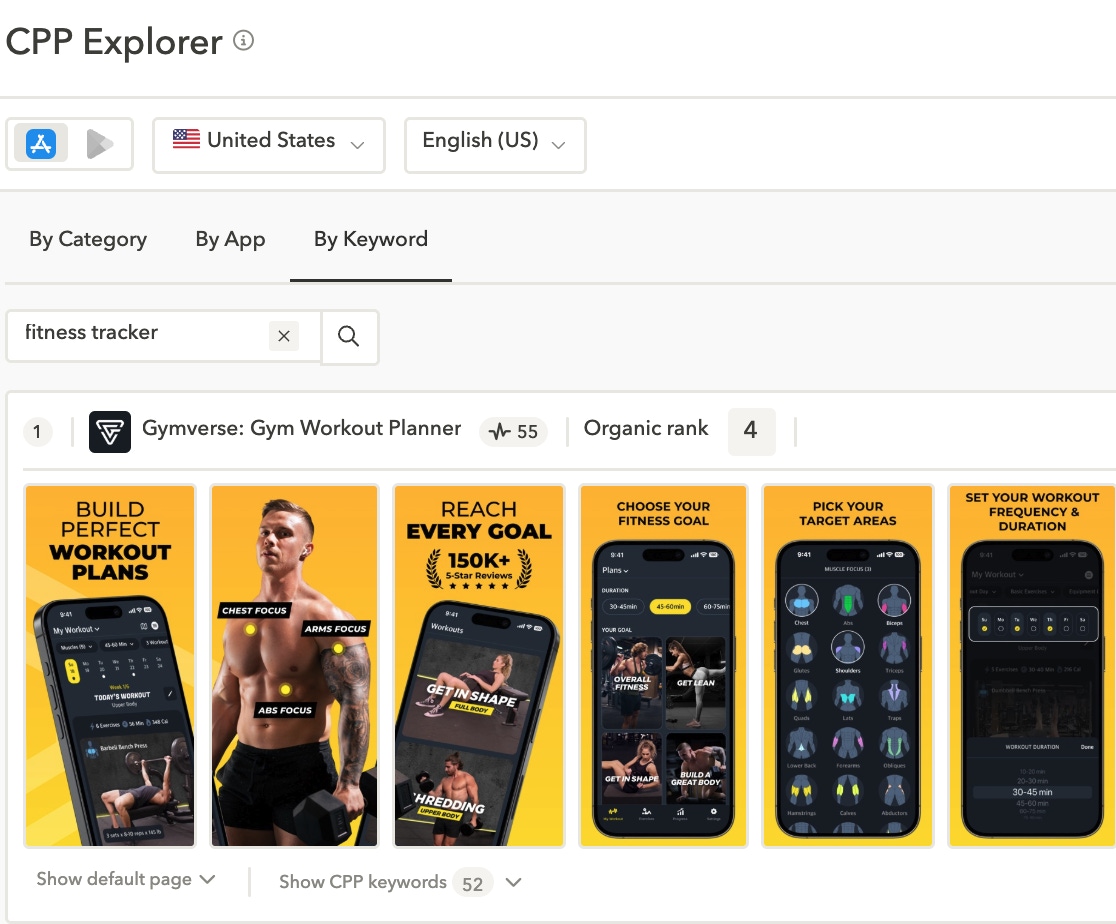
3. Localized bidding and budget allocation
Not all markets behave the same so don’t treat them equally in your Apple Ads campaign structure. Use performance data to set region-specific bids and allocate budget where ROAS is highest.
- Increase bids in high-performing markets (e.g., U.K. or Japan).
- Reduce spend in underperforming or low-priority regions.
- Monitor CPT, CPI, and TTR by country using Apple Ads reporting or AppTweak’s automation dashboard.
You can use AppTweak’s Campaign Manager to set automated rules per geo-location. For instance, “If CPI in Brazil exceeds $4.00, decrease bid by 15%.”
Optimize your bidding strategy
An effective Apple Ads campaign structure is only as good as the bidding strategy behind it. Whether you’re running brand protection campaigns or testing new keyword opportunities, bid optimization is key to controlling CPT, maximizing ROAS, and scaling efficiently.
The good news? You don’t need guesswork. You need a data-driven, rule-based approach tailored to your campaign goals. Below, we outline a structured framework to help you get the most out of your Apple Ads bidding strategy.
Start with intent-based bid segmentation for your Apple Ads campaign structure
Not all keywords carry the same value. When structuring your Apple Ads campaigns, group keywords based on user intent and adjust bids accordingly:
- High-intent keywords (e.g., exact brand terms): Bid competitively to secure conversions at low CPT.
- Category or feature keywords: Test moderate bids to gauge user acquisition cost.
- Competitor keywords: Consider lower bids initially as these terms may have higher CPI due to user hesitation or weaker brand affinity.
- Discovery terms: Keep bids controlled while collecting data to identify performance potential.
Expert Tip
Use our Ad Intelligence tool to track real-time keyword performance and prioritize bidding on terms with the strongest conversion signals to improve your Apple Ads campaign structure.
Adjust bids based on real performance data
Rely on in-platform insights and AppTweak’s dashboards to inform your bid adjustments:
- Lower bids on keywords with high CPI and low retention.
- Raise bids on terms with strong ROAS or low CPI.
- Monitor tap-through rate (TTR) and conversion rate (CVR) for each ad group to determine which keywords justify increased spend.
Examples:
- If your “budget planner app” keyword yields a 3% TTR and $1.20 CPI, consider increasing the CPT bid to gain more impressions.
- Conversely, if “expense tracking app” has a $4.50 CPI with poor install quality, reduce the bid or move it to a discovery campaign.
Use automation to scale your bidding strategy
As your Apple Ads campaigns grow more complex—with multiple regions, match types, and objectives—automation becomes essential for efficiency and responsiveness. That’s where AppTweak’s Campaign Manager comes in.
With automation, you can:
- Set custom rules to raise or lower bids based on CPI, ROAS, or other KPIs.
- React quickly to shifts in keyword performance without constant monitoring.
- Scale your Apple Ads campaign structure without spreadsheet fatigue.

Allocate more budget to top-performing campaigns and geos
Once you’ve identified which campaigns, ad groups, or regions are driving the best results, reallocate your budget to capitalize on those opportunities:
- Increase daily caps for brand or competitor campaigns with strong ROAS.
- Shift budget from underperforming broad match discovery campaigns to high-converting, highly-specific keyword ad groups.
- Consider higher bids in high-value regions where localized campaigns are working well.
Step 7: Optimize your metadata for higher conversions
Your Apple Ads campaign structure can attract the right users, but guess what? Your app store metadata is what ultimately converts them. If your title, subtitle, and description aren’t aligned with what your ads promise, you risk losing installs at the final step.
Metadata optimization is especially important for Search Match campaigns, where Apple automatically generates ads based on your app’s metadata. It’s also critical for ensuring alignment between paid and organic keyword strategies.
Prioritize keyword coverage and relevance
- Use high-intent, conversion-focused keywords in your app title and subtitle.
- Ensure the keywords you bid on in Apple Ads are reflected in your metadata fields.
- Avoid keyword stuffing: Clarity and keyword alignment matter more than keyword count.
How to structure brand campaigns?
Brand campaigns target users who are specifically searching for your app’s name or related branded terms. These campaigns are crucial for defending your app from competitors and ensuring that potential users find you easily. Typically, these campaigns deliver the highest TTR and the lowest CPT due to the strong intent behind branded searches.
To minimize irrelevant impressions and protect your brand, focus your brand campaigns on exact match branded keywords that align closely with your app name and variants. This targeted approach helps reduce competition and ensures efficient spend.

Here are a few ways to structure your brand campaigns depending on your size, popularity, and the uniqueness of your brand name:
1. Single ad group structure
All branded keywords are grouped into a single ad group, typically using precise, branded terms that reflect your app name and related queries. This structure works well for smaller brands or apps with limited resources and a straightforward brand presence, where only a few branded terms require minimal segmentation.
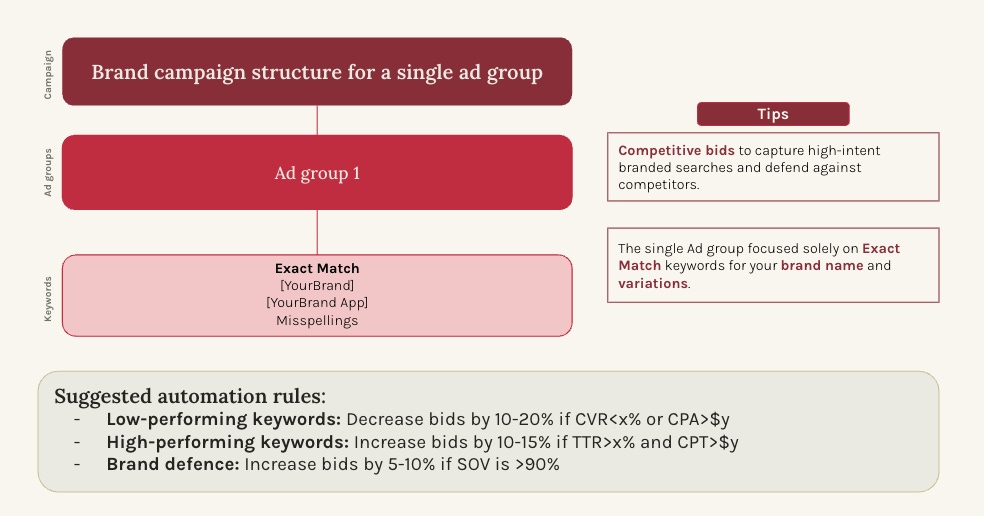
| Pros and cons of using a single branded ad group | |
|---|---|
| Pros | Cons |
| Simplified management: Grouping all branded keywords under one structure makes it easier to manage and optimize your campaign. You can quickly adjust bids and settings without juggling multiple ad groups. | Limited strategic control: It’s harder to apply different strategies or bids for specific types of branded searches (e.g., misspellings, feature-related queries) when everything is grouped together. |
| Clear overview of performance: With all branded terms consolidated, it’s straightforward to monitor and analyze performance from a single view. This works well with reporting features in tools like AppTweak’s Campaign Manager. | Reduced targeting precision: Without segmentation, you may miss opportunities to fine-tune performance for different branded queries, such as partial brand searches or common variants. |
| Lower maintenance: Fewer structures mean less ongoing upkeep, making it easier to manage campaigns—especially when running multiple efforts or operating with limited resources. | Higher risk of wasted spend: Treating all branded terms equally can lead to overinvestment in lower-performing keywords. Segmenting may offer better control over budget allocation. |
Expert Tip
Use exact match keywords in your Apple Ads campaign structure: Focus solely on branded keywords that closely match how users search for your app by name. This helps capture high-intent users, avoid bidding on unrelated terms, and keep costs low. To indicate a precise match in your keyword list, use square brackets, ( e.g., [spotify] ).2. Multiple ad groups structure
Brands with high traffic volume and diverse branded search behavior (e.g., brand-related queries, misspellings, or feature-based searches) can benefit from using multiple ad groups. This structure allows you to segment keywords based on user intent or query variations, such as brand vs. competitor terms, or brand + feature combinations, for more granular control and performance optimization.
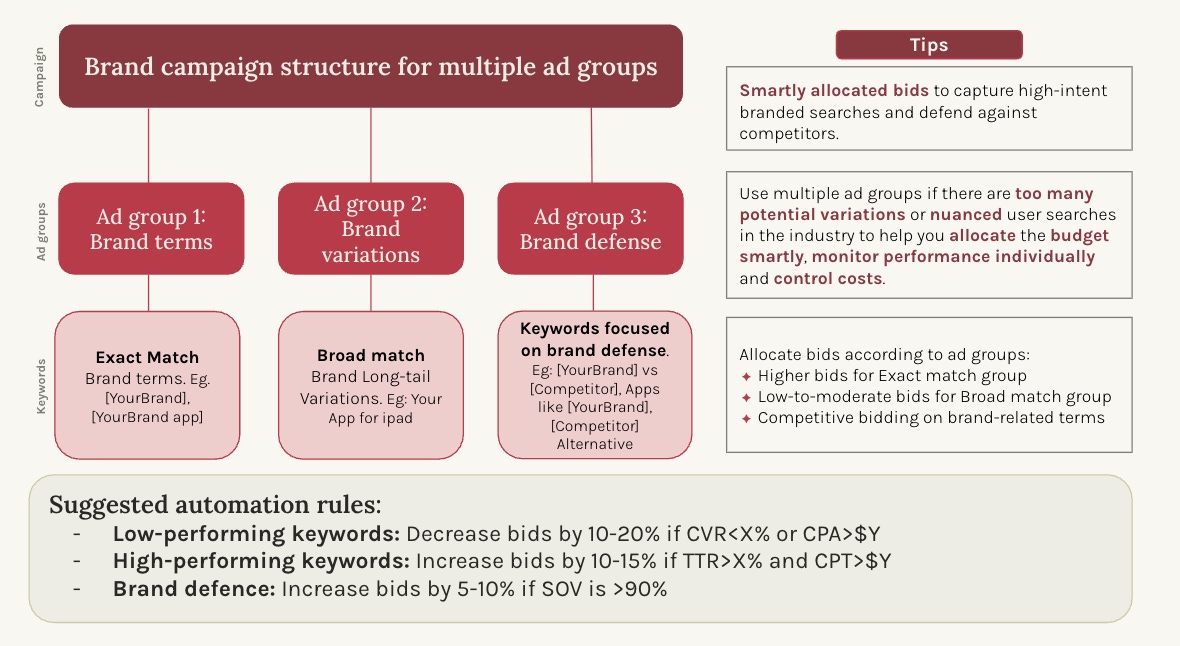
| Pros and cons of multiple ad group brand campaigns | |
|---|---|
| Granular control: Multiple ad groups allow you to apply different bids, budgets, and strategies to various branded search types. | Higher management complexity: Multiple ad groups require more time and effort to manage. You’ll need to regularly monitor and optimize each group to maintain efficient performance. |
| Better budget allocation: By splitting branded terms into distinct ad groups, you can allocate spend more effectively, ensuring your most valuable branded searches receive the majority of your budget. | Data fragmentation: When branded terms are spread across ad groups, it can be harder to get a quick, consolidated view of campaign performance. |
| Tailored ads and landing pages: You can use different Custom Product Pages (CPPs) or creatives tailored to specific branded queries, improving relevance and conversion rates. | Risk of over-segmentation: Too much segmentation can create a complicated structure with diminishing returns, especially when search volume is low. |
| Mitigation of competitor targeting: Competitors may bid on branded terms. Multiple ad groups allow you to allocate more resources toward defending key branded terms and protecting your brand traffic. |
Tips for branded campaign success
After helping countless apps run branded campaigns on Apple Ads, these are my top tips.
Protect your branded presence
Ensure your brand is visible when users search for you by name, especially if competitors are actively bidding on your terms. Keeping branded campaigns live with strong bids helps secure traffic and measure lift from upper-funnel activities like Above-The-Line (ATL) campaigns that emphasize reach and visibility.
Keep campaign structure manageable
Whether using a single or multiple ad group setup, ensure your branded campaign remains easy to manage. Prioritize clarity in naming, clean keyword lists, and distinct goals per group to enable smoother optimization for this particular Apple Ads campaign structure.
Monitor branded visibility
AppTweak’s keyword monitoring and competitive insights can help you track fluctuations in branded search volume and benchmark your visibility against others in your category.
How to structure generic campaigns (category campaigns)
Category campaigns in Apple Ads, commonly referred to as “generic campaigns”, are designed to reach users searching for broad, non-branded terms related to your app’s core offerings.
For instance, a meditation app might target keywords like “relaxation” or “stress relief.” These campaigns are essential for scaling reach beyond brand-aware audiences and driving discovery.
You can optimize these campaigns using two main structuring approaches: keyword segmentation and intent-based ad groups.
1. Keyword segmentation
When structuring your category campaigns by keyword segmentation, implement these strategies.
Focus on non-branded keywords
Unlike brand campaigns, category campaigns rely on keywords that describe your app’s core features, services, or category. For example, a fitness app might target search terms like “workouts” or “health tips” to connect with users looking for solutions in that space.
Use exact match keywords for greater control
Select keywords that closely reflect what users are searching for. Prioritizing highly specific, directly relevant terms helps ensure your ads appear for queries that align closely with your app’s value proposition, improving relevance and efficiency.
Use broader keywords for exploration
To expand reach, you can include broader, more thematic keywords. These may uncover additional opportunities but require close monitoring to avoid irrelevant impressions and clicks.
Feature-specific custom product pages
When targeting broader, non-branded terms, align your custom product pages with the specific features users are likely searching for. For example, if you’re aiming to capture interest in “photo editing,” create a custom product page that highlights editing tools, with tailored screenshots and messaging.
2. Intent-based ad groups
Here are best practices when structuring your category campaigns by intent-based ad groups.
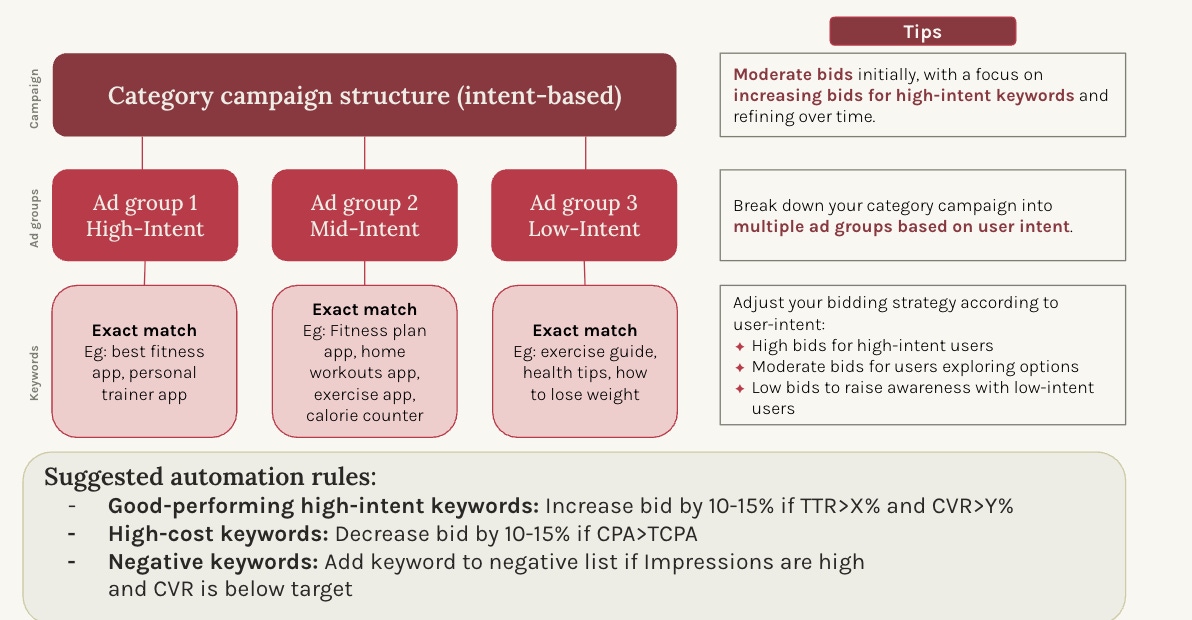
Segment by user intent
Group your ads based on how likely a user is to take action.
For example:
- Users searching for “easy workouts” may be casually exploring options.
- Users searching for “best weight loss programs” may be ready to take immediate action.
Segmenting in this way allows you to better tailor messaging, allocate budget efficiently, and improve campaign performance across the user journey.
Tailor copy and custom product pages to expectations
Use intent-specific messaging and creative assets that reflect what each user segment is looking for:
- For users with higher intent, emphasize calls to action such as “Download now” or highlight key value propositions.
- For those with lower intent, focus on educational content that introduces your app’s features and benefits.
Match custom product pages to intent
Develop distinct custom product pages that align with the search intent of each group. For example, a high-intent ad group might use a custom product page that showcases premium features or a clear value-driven message, while a lower-intent group might benefit from a custom product page that educates and builds awareness. Doing this can improve your TTR.
Check out our best practices for custom product pages for top tips!
Utilize highly specific keywords for higher controlWhile broad match keywords can be useful for discovery, using very specific keywords in category campaigns gives you more control over which terms trigger your ads, preventing irrelevant matches.
Refine keywords with performance data
Continuously review and refine keyword performance to focus on the terms that bring the highest ROI, while excluding underperforming or irrelevant ones. AppTweak’s Campaign Manager will help you automate this process for faster scaling!
A/B test and learn
Test multiple custom product pages within your category campaign to determine which features and pages drive the best conversion rates for each ad group.
How to structure competitor campaigns?
Competitor campaigns are designed to capture users who are exploring apps similar to yours (and those apps are likely your competitors). While these campaigns can have higher acquisition costs and lower conversion rates due to increased competition, they can still be valuable for improving visibility during comparison moments and offering users a relevant alternative.
To enhance performance, consider segmenting your campaign based on user intent or by the core value propositions of your competitors. This allows you to group and structure your targeting more effectively.
Campaign structure options:
1. Single ad group: Use a single ad group that includes highly specific keywords related to competitor brands or categories.
- Direct competitor focus: Group apps with similar features and audience to your own.
- Comparison strategy: Include keywords where users may be comparing your app to others (e.g., “[your app] vs. [competitor]”).
2. Multiple ad groups: Create separate ad groups for individual competitors or clusters of similar competitors. This allows for more granular performance tracking and tailored messaging.
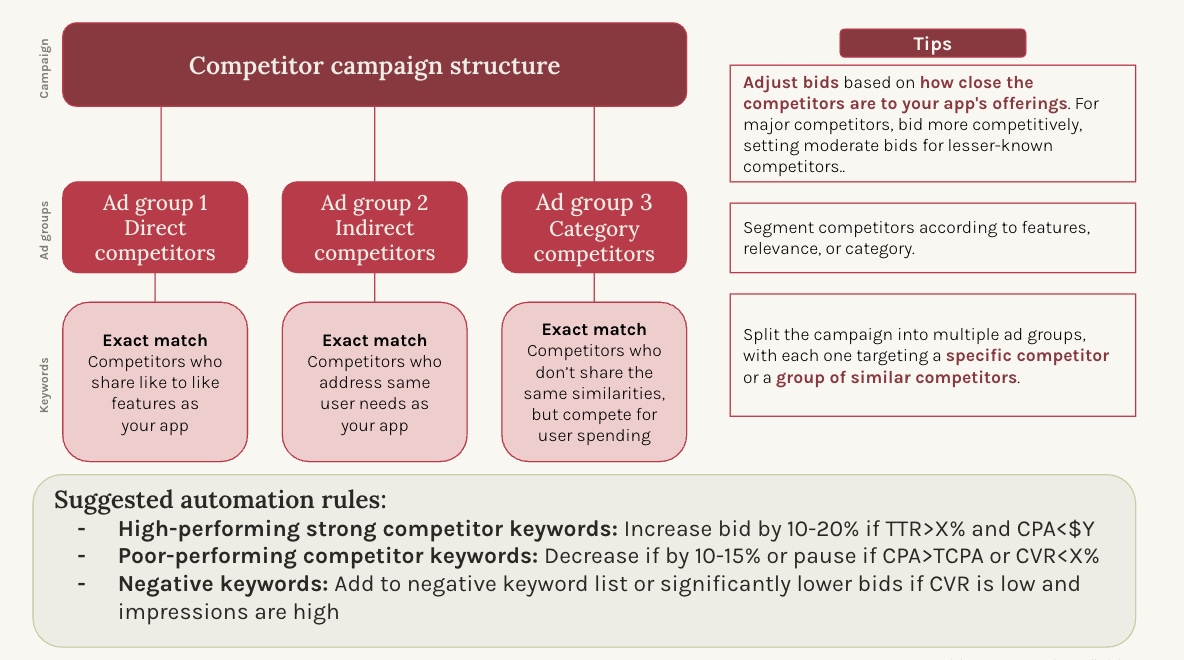
Additionally, with the help of custom product pages, you can segment your competitor campaigns according to user intent and tailor the messaging while targeting competitor keywords.
- Focus on key competitors: Target keywords related to your direct competitors. Be selective about which competitor names you target, prioritizing those that share a user base similar to yours.
In the example below from AppTweak, we can see that the language learning app Babbel appears at the top of search results for the branded term “Duolingo” in the U.S. App Store. This illustrates a competitor campaign strategy, where an app positions itself alongside similar offerings during high-intent user searches.

- Monitor costs closely: Competitor campaigns tend to have higher cost per acquisition (CPA) due to intense competition. Keep an eye on the performance of each keyword and adjust your bids to prevent overspending.
- Use exploratory keywords with caution: While utilizing exploratory terms can increase reach, it may also lead to irrelevant clicks. Use it sparingly or rely on highly-specific terms to control costs more effectively.
- Leverage differentiation in custom product pages: Highlight ways your app outperforms the competitors such as with better features, pricing, user experience, testimonials etc., in your custom product pages.
How to structure discovery campaigns?
Discovery campaigns are designed to help you uncover new keywords and expand your reach by leveraging Apple’s Search Match feature. Rather than requiring manual keyword selection, Search Match automatically matches your ads to relevant search terms based on your app’s metadata, category, and content from similar apps.
These campaigns are ideal for keyword exploration, particularly in the early stages of a campaign or when scaling. However, since performance can vary widely, it’s important to monitor closely and optimize regularly to maintain cost-efficiency.
The two ad group types of discovery campaigns
A discovery campaign typically includes two ad group types:
- Exploratory keywords: Include a broad range of keywords previously used in your brand, category, and competitor campaigns. This group should have Search Match disabled and is intended to help you explore new keyword variations or combinations that weren’t part of your core strategy.
- Search Match: Enable Apple’s Search Match feature to automatically match your ads with relevant search queries. This approach helps uncover untapped keyword opportunities that align with your app’s metadata and category.
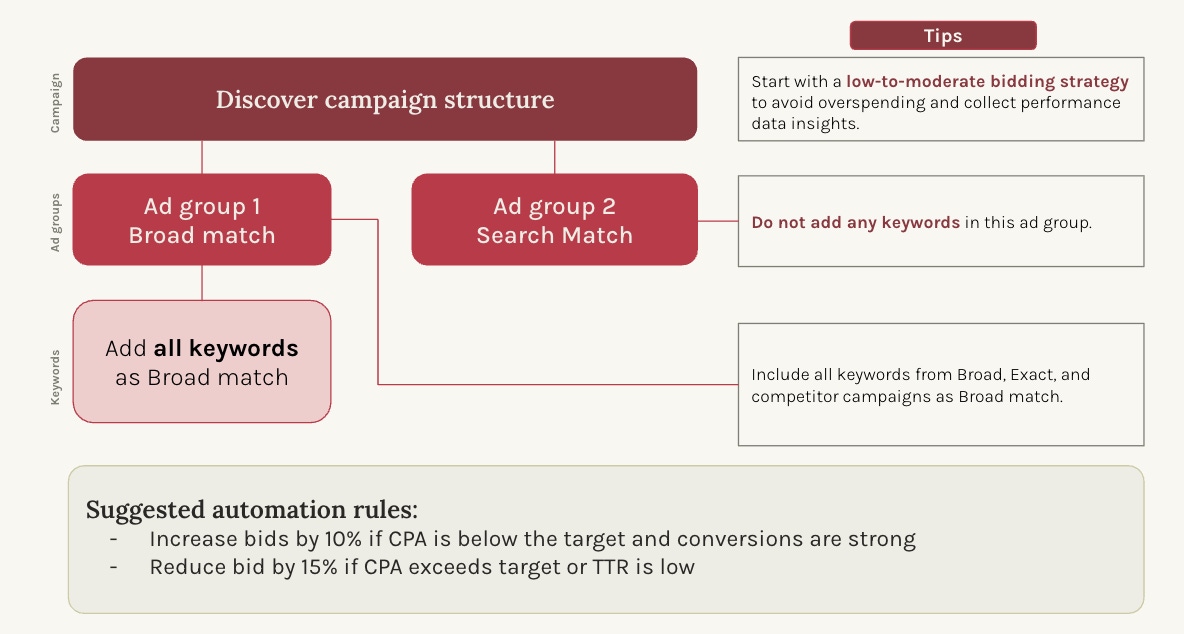
Best practices for discovery campaigns
Here are my suggestions for setting your discovery campaigns up for success.
- Minimize keyword duplication: Add high-performing keywords from your other campaigns to the negative keyword list in your discovery campaign. This helps prevent duplicated coverage and inefficient bidding.
- Set clear CPA goals: Since discovery campaigns can generate broad traffic, it’s important to define CPA goals early and adjust bids accordingly to stay within budget.
- Test before scaling: Use discovery campaigns as a testing ground. Begin with a small budget, identify high-performing keywords, and then shift those keywords into more targeted campaigns for better performance control.
- Automate for efficiency: Start with conservative bids to collect data, then gradually increase bids or shift effective keywords to higher-priority ad groups as performance insights develop.
How to structure proxy campaigns?
Proxy campaigns help you test newly discovered keywords from your discovery campaigns in a more focused, controlled setting. Integration with a Mobile Measurement Partner (MMP) can make these campaigns even more effective, as it allows you to identify the true value of each search term.
By isolating these search terms in their own ad groups, you can evaluate their performance before transitioning them to your main brand, category, or competitor campaigns—where you can apply higher bids and more tailored messaging.
Proxy campaigns bridge the gap between exploratory discovery and stable, well-performing campaigns. This analytical approach helps refine your keyword strategy, manage costs more effectively, and identify which search terms are most likely to deliver strong results.
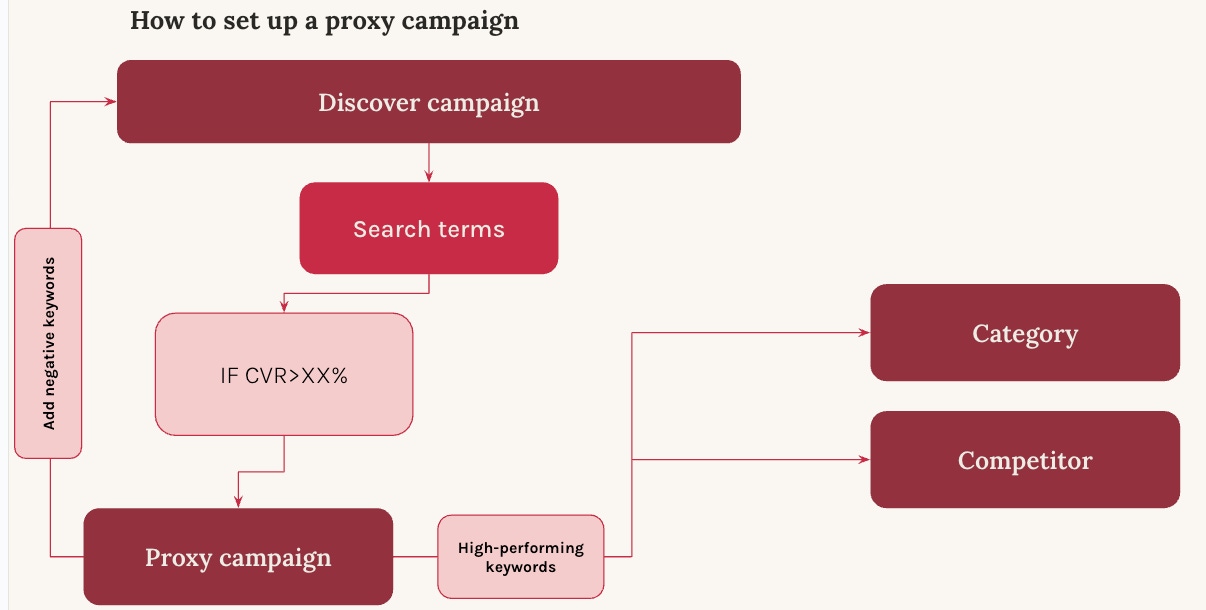
Top tips for proxy campaigns
If you’re about to set up your proxy campaign, consider the following.
Move high-performing keywords
Once a keyword shows strong potential, assign it to its own ad group within your proxy campaign. This allows you to monitor performance in more detail and allocate budget more efficiently.
Test bidding strategies
Use proxy campaigns to experiment with different bid levels and performance thresholds. Adjust based on CPA and other key metrics to find the most effective bidding strategy for each keyword.
Exclude underperforming keywords
If a keyword consistently fails to deliver value, remove it from your strategy or keep it excluded from other campaign types. Proxy campaigns are designed for refinement, focusing only on terms that demonstrate clear potential.
Conclusion: Focus on your Apple Ads campaign structure
Structuring your Apple Ads campaigns effectively is not just a best practice; it’s a growth strategy. From defining your goals to refining your metadata, each step plays a crucial role in helping you attract high-intent users, manage budgets efficiently, and maximize return on ad spend.
Whether you’re launching brand defense campaigns, experimenting with discovery and proxy setups, or scaling globally through localization, the key is alignment. Alignment between your keywords, creatives, user intent, and app store presence ensures that every tap counts.
At AppTweak, we help you take the guesswork out of structuring Apple Ads campaigns. With automation tools, keyword insights, and competitive benchmarks, you can build smarter campaigns that are structured to succeed.
FAQs for Apple Ads campaign structure
Below we answer your top questions about structuring your Apple Ads campaigns.
What is an Apple Ads campaign?
An Apple Ads campaign is a structured set of ads, ad groups, and keywords designed to promote an app on the App Store. At the campaign level, you set your budget and choose where your ads will run (such as specific countries or regions and App Store placements).
Within each campaign, you can organize ad groups by keyword themes or audience targets, set bids, and manage ad creatives. This structure helps you control spending, target relevant users, and track performance effectively.
How should I structure my Apple Ads campaigns?
At AppTweak, we recommend structuring your Apple Ads campaigns by separating them into four main types, each focused on a specific keyword theme.
- Brand Campaign: Targets keywords related to your app or company name. Use exact match keywords and turn off Search Match.
- Category Campaign: Targets non-branded keywords that describe your app’s category or features. Use exact match keywords and turn off Search Match.
- Competitor Campaign: Targets keywords related to similar or competing apps. Use exact match keywords and turn off Search Match.
- Discovery Campaign: Designed to find new keyword opportunities. Use exploratory match keywords and Search Match. Create two ad groups: one with exploratory match (Search Match off) and one with only Search Match (no keywords). Add the keywords from your other campaigns as highly-specific match negatives to avoid overlap.
This structure makes it easier to track performance, optimize bids, and scale campaigns by country or region. Regularly review discovery campaign results to add new high-performing keywords to your core campaigns.
What campaign types exist in Apple Ads?
Brand campaigns, category campaigns, competitor campaigns, discovery campaigns, and placement-based are campaign types in Apple Ads. Here’s a breakdown of each:
- Brand campaigns: Target users searching for your app or company name.
- Category campaigns: Focus on generic, non-branded keywords related to your app’s function or category.
- Competitor campaigns: Target keywords associated with rival or similar apps.
- Discovery campaigns: Use broad match and Search Match to uncover new, high-performing keywords.
How do I build a campaign in Apple Ads?
To build a campaign in Apple Ads, log in to your Apple Ads account and click “Create Campaign.” Select the app you want to promote, choose your ad placement (such as Search Results or Today tab), and pick your target countries or regions. Next, set your daily budget, name your campaign, and create ad groups with relevant keywords and bids.
You can organize campaigns by themes like Brand, Category, Competitor, or Discovery. Review your settings, then launch your campaign. Monitor performance regularly with AppTweak, and adjust keywords, bids, or targeting to optimize results.
Which Apple Ads best practices should I put in place?
Key Apple Ads best practices include, optimizing your app metadata before starting your campaign, establishing a clear naming convention, structuring your search results by keyword theme, avoiding budget saturation, and adding negative keywords, to name a few. For a deep dive, check out our blog on Apple Ads tips and best practices.
Here’s some more context on the best practices for Apple Ads:
- Refresh your app metadata before starting a campaign, as ad creatives are generated from your App Store listing. Make sure your icon, title, subtitle, and screenshots are up-to-date and reflect your app’s core experience.
- Set up a clear naming convention for campaigns and ad groups (include app name, country, campaign type, and keyword match type) to keep your account organized and easy to manage.
- Structure search results campaigns by keyword theme: Separate campaigns for Brand, Generic (Category), Competitor, and Discovery. This helps with performance tracking and optimization.
- Use both broad match and exact match keywords to maximize reach and discover high-performing terms. For Brand, Category, and Competitor campaigns, use exact match and turn off Search Match. Use Discovery campaigns with broad match and Search Match to find new keywords.
- Avoid budget saturation Monitor your daily budget to avoid budget saturation (hitting your daily cap can limit impressions and performance).
- Give discovery campaigns time to gather data before making changes, as it can take a few weeks for Apple to match your app with relevant search terms.
- Add negative keywords to prevent your ads from showing for irrelevant or overlapping search terms, especially in discovery campaigns.
- Choose “Reach All Eligible Users” for maximum reach unless you have a specific targeting need.
- Launch initial campaigns without a CPA cap to avoid limiting impressions, then set a CPA cap once you understand performance.
- Adjust max CPT (cost-per-tap) bids based on campaign theme and match type—invest more in exact match campaigns for better control.
- Leverage custom product pages (CPPs) to deliver more relevant ad experiences to different audience segments.
- Continuously monitor and optimize your campaigns, adjusting bids, budgets, and keywords based on performance data.
- Integrate Apple Ads with your ASO strategy to boost organic visibility and conversion rates by applying high-performing keywords across both channels
What are common Apple Ads campaign structure mistakes?
Common mistakes marketers make when structuring their Apple Ads campaigns include mixing different keyword themes, not adding negative keywords in discovery campaigns, failing to segment ad groups by user intent, and not leveraging discovery campaigns to find new high-performing keywords for core campaigns.
- Mixing different keyword themes (brand, category, competitor, discovery) in the same campaign instead of separating them, which makes performance tracking and optimization difficult.
- Using broad match or Search Match in brand, category, or competitor campaigns, instead of exact match for precise targeting.
- Not adding negative keywords in discovery campaigns, causing overlap and wasted spend on keywords already targeted elsewhere.
- Failing to segment ad groups by user intent or keyword relevance, which can lead to inefficient bidding and poor ad relevance.
- Running global campaigns without considering regional differences, which can reduce effectiveness and increase costs.
- Not leveraging discovery campaigns to find new high-performing keywords for core campaigns.
- Overcomplicating the structure or not aligning it with clear business goals, making analysis and scaling harder



 Simon Thillay
Simon Thillay

 Micah Motta
Micah Motta

 Georgia Shepherd
Georgia Shepherd